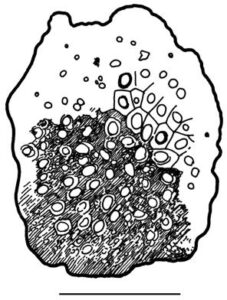Fungalpedia – Note 262, Ratnagiriathyrites (Fossil Fungi)
Ratnagiriathyrites R.K. Saxena & N.K. Misra.
Citation when using this data: Saxena RK & Hyde KD. 2024 (in prep)– Fungalpedia, Fossil Fungi.
Index Fungorum, Facesoffungi, MycoBank, GenBank, Fig. 1
Classification: Fossil Ascomycota, Dothideomycetes, Microthyriales.
The monotypic fossil genus, Ratnagiriathyrites, was introduced by Saxena & Misra (1990) from the Ratnagiri beds (Neogene, 23–2.6 mya) of Amberiwadi Section, Sindhudurg District, Maharashtra, India. Ratnagiriathyrites is characterized by subcircular or irregularly shaped, dark brown, non-ostiolate ascostromata. Cells not arranged radially, porate, pores generally distributed throughout stromata, cells hexagonal, bigger towards periphery than in the central region; margin thick, wavy. The name of the genus is after Ratnagiri beds from where it was recovered.
Worobiec et al. (2020) reviewed the fossil species Ratnagiriathyrites hexagonalis, first identified from Neogene strata in Maharashtra, India. They suggest that the central arrangement of large pores inside the cells, a morphological hallmark of Ratnagiriathyrites, is more in line with the extinct species Cribrites. Ratnagiriathyrites hexagonalis is therefore now regarded as an earlier synonym of Cribrites, highlighting the need for thorough morphological investigation in classifying fossils and reassessing previously recognized taxa.
Type species: Ratnagiriathyrites hexagonalis R.K. Saxena & N.K. Misra.
Homotypic synonyms: Cribrites hexagonalis (R.K. Saxena & N.K. Misra) G. Worobiec.
Figure 1 – Ratnagiriathyrites hexagonalis. Scale bar = 5 μm. Redrawn from Saxena & Misra (1990).
References
Entry by
Ramesh K. Saxena, Birbal Sahni Institute of Palaeosciences, Lucknow, India
Edited by Kevin D. Hyde, Samaneh Chaharmiri-Dokhaharani
Published online 21 May 2024
